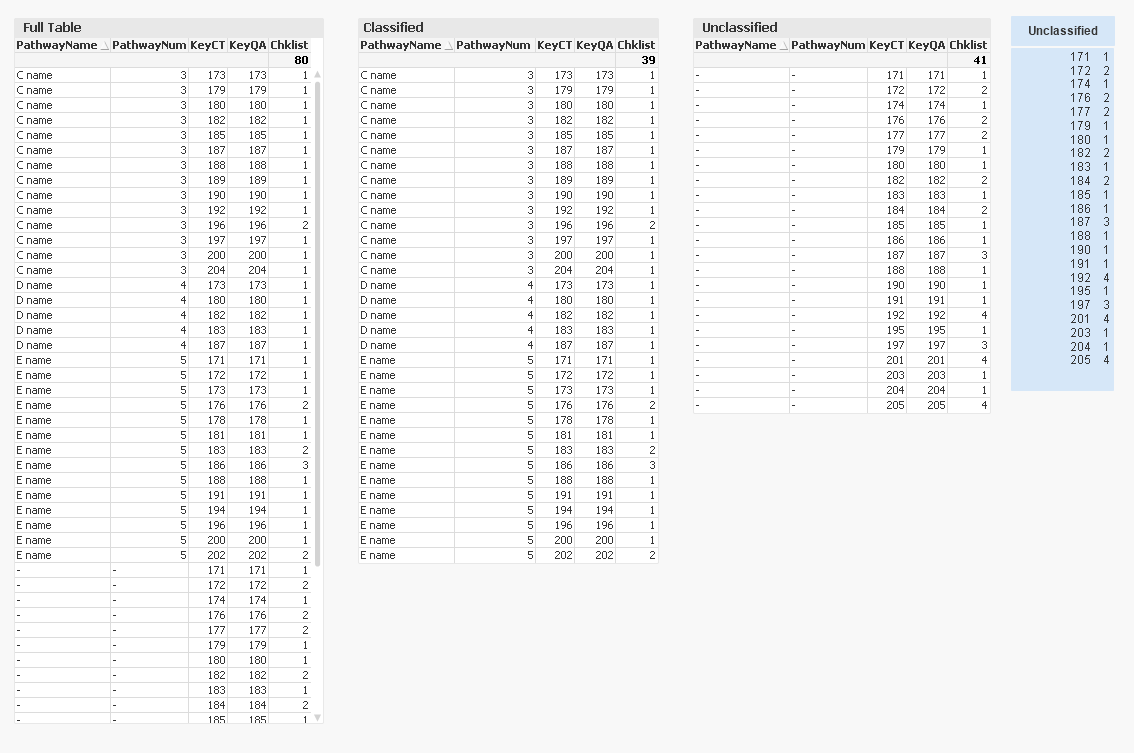Unlock a world of possibilities! Login now and discover the exclusive benefits awaiting you.
- Qlik Community
- :
- All Forums
- :
- QlikView App Dev
- :
- Re: How to show uncategorised rows?
- Subscribe to RSS Feed
- Mark Topic as New
- Mark Topic as Read
- Float this Topic for Current User
- Bookmark
- Subscribe
- Mute
- Printer Friendly Page
- Mark as New
- Bookmark
- Subscribe
- Mute
- Subscribe to RSS Feed
- Permalink
- Report Inappropriate Content
How to show uncategorised rows?
When using a table (versus a pivot table) - I have a number of rows which do not fit into my classification and they appear as a blank rows but it is valuable information. Is there a way of showing this information in a text box?
The table is shown below.
Also
I want to show all values - so set analysis - how do I do this with an aggr?
count(aggr((DateQA - DateCT),PatIDCreate_Date))
Thank you
Jo
- Tags:
- table vs pivot table
Accepted Solutions
- Mark as New
- Bookmark
- Subscribe
- Mute
- Subscribe to RSS Feed
- Permalink
- Report Inappropriate Content
Are you looking for something like this?

I have attached the QlikView app
- Mark as New
- Bookmark
- Subscribe
- Mute
- Subscribe to RSS Feed
- Permalink
- Report Inappropriate Content
I am not sure, I understand fully, Try from Show all values check of dimension, How date format seems
Try like this
Aggr(count((DateQA - DateCT),PatIDCreate_Date))
- Mark as New
- Bookmark
- Subscribe
- Mute
- Subscribe to RSS Feed
- Permalink
- Report Inappropriate Content
Are you looking for something like this?

I have attached the QlikView app
- Mark as New
- Bookmark
- Subscribe
- Mute
- Subscribe to RSS Feed
- Permalink
- Report Inappropriate Content
Hi ANIL
Aggr(count((DateQA - DateCT),PatIDCreate_Date))
no this did not work - I wanted something like
count({1}Aggr(count((DateQA - DateCT),PatIDCreate_Date))
???
Jo
- Mark as New
- Bookmark
- Subscribe
- Mute
- Subscribe to RSS Feed
- Permalink
- Report Inappropriate Content
Thank you Petter
ok so:
the full table: Sum(Chklist)
Classified Table: Sum( {<PathwayName={"*"}>} Chklist)
Unclassified table; Sum( {1-<PathwayName={"*"}>} Chklist)
text Object:
=Concat(
Aggr(
Concat( DISTINCT {1-<PathwayName={"*"}>} KeyQA ) & ' ' & Sum( {1-<PathwayName={"*"}>} Chklist)
, PathwayName // Group by PathwayName
, PathwayNum // and PathwayNum
, KeyQA // and KeyQA
)
, Chr(10) // use a linefeed between the values in the textbox
, KeyQA // order the list by KeyQA
)
so the difference between the Classified and the Unclassified is the (1 - ) - so if I understand:
Classified Table responds to anything with a PathwayName,
but in the Unclassified table it responds to everything except those with a PathwayName.
Thank you for your help (I always find it funny that I am the one asking the question and then saying the answer is correct! ![]() Like the pupil telling the Master - you are correct
Like the pupil telling the Master - you are correct ![]()
Jo